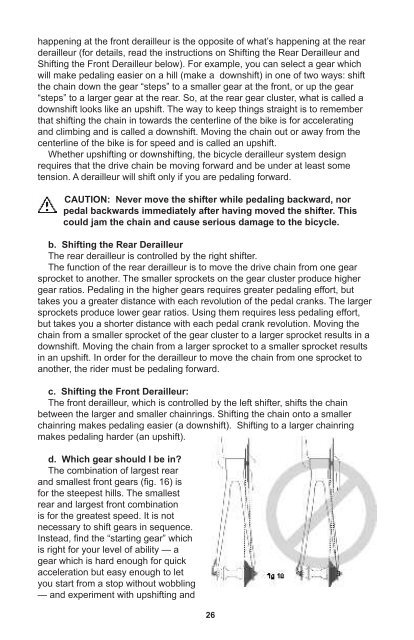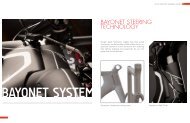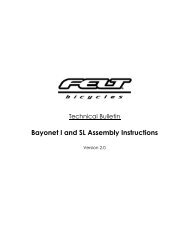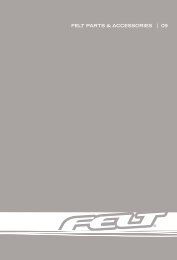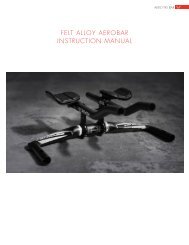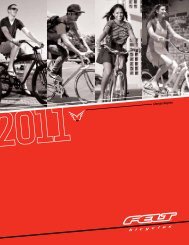Bicycle Owners Manual - Felt Bicycles
Bicycle Owners Manual - Felt Bicycles
Bicycle Owners Manual - Felt Bicycles
Create successful ePaper yourself
Turn your PDF publications into a flip-book with our unique Google optimized e-Paper software.
happening at the front derailleur is the opposite of what’s happening at the rear<br />
derailleur (for details, read the instructions on Shifting the Rear Derailleur and<br />
Shifting the Front Derailleur below). For example, you can select a gear which<br />
will make pedaling easier on a hill (make a downshift) in one of two ways: shift<br />
the chain down the gear “steps” to a smaller gear at the front, or up the gear<br />
“steps” to a larger gear at the rear. So, at the rear gear cluster, what is called a<br />
downshift looks like an upshift. The way to keep things straight is to remember<br />
that shifting the chain in towards the centerline of the bike is for accelerating<br />
and climbing and is called a downshift. Moving the chain out or away from the<br />
centerline of the bike is for speed and is called an upshift.<br />
Whether upshifting or downshifting, the bicycle derailleur system design<br />
requires that the drive chain be moving forward and be under at least some<br />
tension. A derailleur will shift only if you are pedaling forward.<br />
CAUTION: Never move the shifter while pedaling backward, nor<br />
pedal backwards immediately after having moved the shifter. This<br />
could jam the chain and cause serious damage to the bicycle.<br />
b. Shifting the Rear Derailleur<br />
The rear derailleur is controlled by the right shifter.<br />
The function of the rear derailleur is to move the drive chain from one gear<br />
sprocket to another. The smaller sprockets on the gear cluster produce higher<br />
gear ratios. Pedaling in the higher gears requires greater pedaling effort, but<br />
takes you a greater distance with each revolution of the pedal cranks. The larger<br />
sprockets produce lower gear ratios. Using them requires less pedaling effort,<br />
but takes you a shorter distance with each pedal crank revolution. Moving the<br />
chain from a smaller sprocket of the gear cluster to a larger sprocket results in a<br />
downshift. Moving the chain from a larger sprocket to a smaller sprocket results<br />
in an upshift. In order for the derailleur to move the chain from one sprocket to<br />
another, the rider must be pedaling forward.<br />
c. Shifting the Front Derailleur:<br />
The front derailleur, which is controlled by the left shifter, shifts the chain<br />
between the larger and smaller chainrings. Shifting the chain onto a smaller<br />
chainring makes pedaling easier (a downshift). Shifting to a larger chainring<br />
makes pedaling harder (an upshift).<br />
d. Which gear should I be in<br />
The combination of largest rear<br />
and smallest front gears (fig. 16) is<br />
for the steepest hills. The smallest<br />
rear and largest front combination<br />
is for the greatest speed. It is not<br />
necessary to shift gears in sequence.<br />
Instead, find the “starting gear” which<br />
is right for your level of ability — a<br />
gear which is hard enough for quick<br />
acceleration but easy enough to let<br />
you start from a stop without wobbling<br />
— and experiment with upshifting and<br />
downshifting to get a feel for the different gear combinations. At first, practice<br />
shifting where there are no obstacles, hazards or other traffic, until you’ve built<br />
up your confidence. Learn to anticipate the need to shift, and shift to a lower gear<br />
before the hill gets too steep. If you have difficulties with shifting, the problem<br />
could be mechanical adjustment. See your dealer for help.<br />
WARNING: Never shift a derailleur onto the largest or the smallest<br />
sprocket if the derailleur is not shifting smoothly. The derailleur may<br />
be out of adjustment and the chain could jam, causing you to lose<br />
control and fall.<br />
e. What if it won’t shift gears<br />
If moving the shift control one click repeatedly fails to result in a smooth shift to<br />
the next gear chances are that the mechanism is out of adjustment. Take the bike<br />
to your dealer to have it adjusted.<br />
2. How an internal gear hub drivetrain works<br />
If your bicycle has an internal gear hub drivetrain, the gear changing<br />
mechanism will consist of:<br />
• a 3, 5, 7, 8, 12 speed or possibly an infinitely variable internal gear hub<br />
• one, or sometimes two shifters<br />
• one or two control cables<br />
• one front sprocket called a chainring<br />
• a drive chain<br />
a. Shifting internal gear hub gears<br />
Shifting with an internal gear hub drivetrain is simply a matter of moving the<br />
shifter to the indicated position for the desired gear ratio. After you have moved<br />
the shifter to the gear position of your choice, ease the pressure on the pedals<br />
for an instant to allow the hub to complete the shift.<br />
b. Which gear should I be in<br />
The numerically lowest gear (1) is for the steepest hills. The numerically<br />
largest gear is for the greatest speed.<br />
Shifting from an easier, “slower” gear (like 1) to a harder, “faster” gear (like 2 or<br />
3) is called an upshift. Shifting from a harder, “faster” gear to an easier, “slower”<br />
gear is called a downshift. It is not necessary to shift gears in sequence. Instead,<br />
find the “starting gear” for the conditions — a gear which is hard enough for quick<br />
acceleration but easy enough to let you start from a stop without wobbling — and<br />
experiment with upshifting and downshifting to get a feel for the different gears.<br />
At first, practice shifting where there are no obstacles, hazards or other traffic,<br />
until you’ve built up your confidence. Learn to anticipate the need to shift, and<br />
shift to a lower gear before the hill gets too steep. If you have difficulties with<br />
shifting, the problem could be mechanical adjustment. See your dealer for help.<br />
c. What if it won’t shift gears<br />
If moving the shift control one click repeatedly fails to result in a smooth shift to<br />
the next gear chances are that the mechanism is out of adjustment. Take the bike<br />
to your dealer to have it adjusted.<br />
26 27


